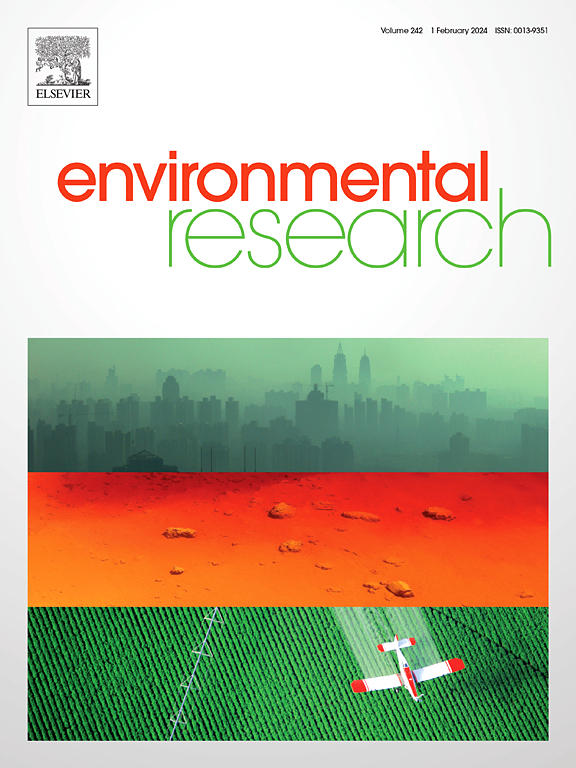An investigation of the engineering properties and environmental impact of low-temperature modified electrolytic manganese residue for karst grouting materials
IF 7.7
2区 环境科学与生态学
Q1 ENVIRONMENTAL SCIENCES
引用次数: 0
Abstract
Electrolytic manganese residue (EMR) has large stockpiles, low reactivity, and high environmental risk. The presence of pollutants such as NH3-N and Mn complicates the direct reuse of disposal sites. A composite activator (CA) is prepared by calcining EMR at a low temperature and mixing it with cement clinker (CC) and calcium carbide slag (CCS) in an optimal ratio. This CA replaces GGBS to create an efficient grouting material. This study analyzes the effect of CA content on the setting time, fluidity, mechanical strength, and impermeability of the grouting material under different water-to-cement ratios. The results show that the EMR-based composite activator, consisting of EMR calcined at 300 °C for 2 h, CCS, and CC, is highly effective. The optimal ratio of EMR to CCS to CC is 25:3:4. The setting time decreases with the increase of water-cement ratio, but gradually decreases with the increase of CA content. Fluidity increases with a higher water-to-cement ratio but decreases with more CA. Both compressive and flexural strengths decrease as the water-to-cement ratio rises. The unconfined compressive strength and flexural strength of EGC could exceeded 24.0 MPa and 5 MPa in 28 days, and the hydraulic conductivity remained below than 10−7 cm/s, which favored the landfill leakage remediation and pollution control. The main hydration products are calcium silicate hydrate (C-S-H), calcium alumino-silicate hydrate (C-A-S-H) and ettringite (AFt), contributing to the formation of network compact structure. The leaching concentrations of Mn and NH3-N in EGC are lower than the threshold values specified in the national standard GB 8978–1996. This innovative grouting material exhibits excellent performance and environmental adaptability, making it a high-quality sealing material for karst disposal sites.

低温改性电解锰渣岩溶注浆材料的工程性能及环境影响研究。
电解锰渣(EMR)储量大,反应性低,环境风险高。NH3-N和Mn等污染物的存在使处置场地的直接再利用变得复杂。将EMR低温煅烧后,与水泥熟料(CC)和电石渣(CCS)按最佳配比混合,制备复合活化剂(CA)。这种CA取代了GGBS,创造了一种高效的注浆材料。本研究分析了不同水灰比下CA含量对注浆材料凝结时间、流动性、机械强度和抗渗性能的影响。结果表明,由300℃煅烧2 h的EMR、CCS和CC组成的EMR基复合活化剂效果良好。EMR与CCS / CC的最佳比值为25:3:4。凝结时间随水灰比的增大而减小,随CA含量的增加而逐渐减小。流动性随水灰比增大而增大,但随CA增大而减小。抗压强度和抗折强度均随水灰比增大而减小。EGC的无侧限抗压强度和抗折强度在28 d内可分别超过24.0 MPa和5MPa,导水率保持在10-7 cm/s以下,有利于填埋场渗漏修复和污染控制。水化产物主要为水合硅酸钙(C-S-H)、水合硅酸铝钙(C-A-S-H)和钙矾石(AFt),形成网状致密结构。EGC中Mn和NH3-N的浸出浓度低于国家标准GB 8978-1996规定的阈值。该新型灌浆材料具有优异的性能和环境适应性,是岩溶处置场地的优质密封材料。
本文章由计算机程序翻译,如有差异,请以英文原文为准。
求助全文
约1分钟内获得全文
求助全文
来源期刊

Environmental Research
环境科学-公共卫生、环境卫生与职业卫生
CiteScore
12.60
自引率
8.40%
发文量
2480
审稿时长
4.7 months
期刊介绍:
The Environmental Research journal presents a broad range of interdisciplinary research, focused on addressing worldwide environmental concerns and featuring innovative findings. Our publication strives to explore relevant anthropogenic issues across various environmental sectors, showcasing practical applications in real-life settings.
 求助内容:
求助内容: 应助结果提醒方式:
应助结果提醒方式:


